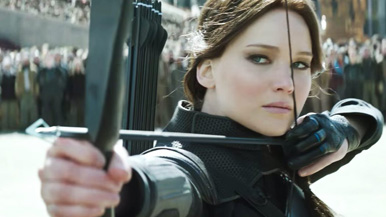Book vs. Movie - The Hunger Games: Mockingjay Part 2
By Ben Gruchow
November 28, 2016
Katniss’ goal in this is simple: she cares nothing for the purpose of the Star Squad, or much of anything having to do with the revolution at all; more or less all of her remaining will to live is set on getting to and killing President Snow for what he’s done to her district and to Peeta. Set against the character positioning here are subplots that threaten to disrupt the proceedings: Peeta is assigned to the Star Squad, ostensibly to provide better optics for the rebels and clearly as a tool designed to reveal Alma Coin’s true sentiments toward Katniss as a future ally: the “good” President doesn’t like or trust the story’s protagonist, views her inability or refusal to merge her goals with Coin’s as a liability, and intends to control the narrative of the Mockingjay regardless of whether or not the actual person is alive or dead.
The Book
If the first half of Mockingjay was about control and manipulation through political propaganda, the second half is about how far exertion of that control and manipulation will be pressed, and what manifestation that control and manipulation takes in order to assert its presence and dominance. In quite another sense, it’s about the failure of risk-averse institutions to maintain a stable and workable emotional temperature in a population prone to populist appeals. Here we have a pretty linear escalation of the core themes encountered in Catching Fire, and there is a sense of inevitability that pervades the final phase of the story’s rising action.
Collins teases the reader pretty effectively with this, drawing the post-Peeta, pre-invasion stretch of the book out with precision. A chunk of the book’s third quarter is given over to Katniss transforming from an undernourished trauma victim to something approximating an adjusted soldier, with Johanna as her companion in both states of physical and mental shape (although the actual passage is done well, the moment where Collins begins structuring the shape of the book’s final act, involving a spur-of-the-moment decision by Coin, positively creaks with wheezy plot mechanics; a follow-up sequence involving a convenient medical procedure to accelerate healing is even more so.
Prior to all this, though, we have what might be the sharpest passage in the final novel, one that acts as a primary moment of reckoning for Katniss’s character arc in the series up to this point. It occurs as the rebels secure District 2, a mountainous region containing most of the Capitol’s defense and weapons arsenal. The workers inside the primary mountain caves are smoked out in destructive fashion, and the moment in question involves a lone, injured miner with a gun. Collins has to this point been building toward the climax of a secondary narrative, that of the districts being led to see each other as enemies. This is, of course, the product of Snow’s incitement to inter-district violence from Catching Fire. This climax arrives when the gun in question is pointed at Katniss, and the sentiment here echoes Peeta’s from the first installment of the series: if you’re going to die, do it in a way that is your own. Of course, the tone behind the sentiment then was one of uneasiness and tension. Here, we have the opposite; this sequence, set at night in a bombed-out ruin and populated by victims of war, exudes not much beyond exhaustion and a kind of get-it-over-with mentality.
Continued:
1
2
3
4
5




